Organizational Change and Communication Analysis: 'Up in the Air'
VerifiedAdded on 2021/06/15
|7
|2017
|61
Essay
AI Summary
This essay analyzes the themes of organizational change and communication as depicted in the movie "Up in the Air." The film serves as a case study, exploring the dynamics between organizations and their employees. It focuses on the protagonist, Ryan Bingham, a corporate downsizer, and examines his approach to employee termination and his solitary lifestyle. The essay delves into the impact of modern technological strategies, such as web-based conferencing, on organizational communication and the challenges they present. It highlights the importance of employee behavior, workplace relationships, and the potential pitfalls of distant communication methods. The essay also discusses the theories of workplace friendship and bullying, as portrayed in the movie, and emphasizes the significance of effective communication in handling employee issues and fostering a positive work environment. The analysis draws from various scholarly sources to support its arguments and concludes with insights into the integral role of organizational communication in business success.
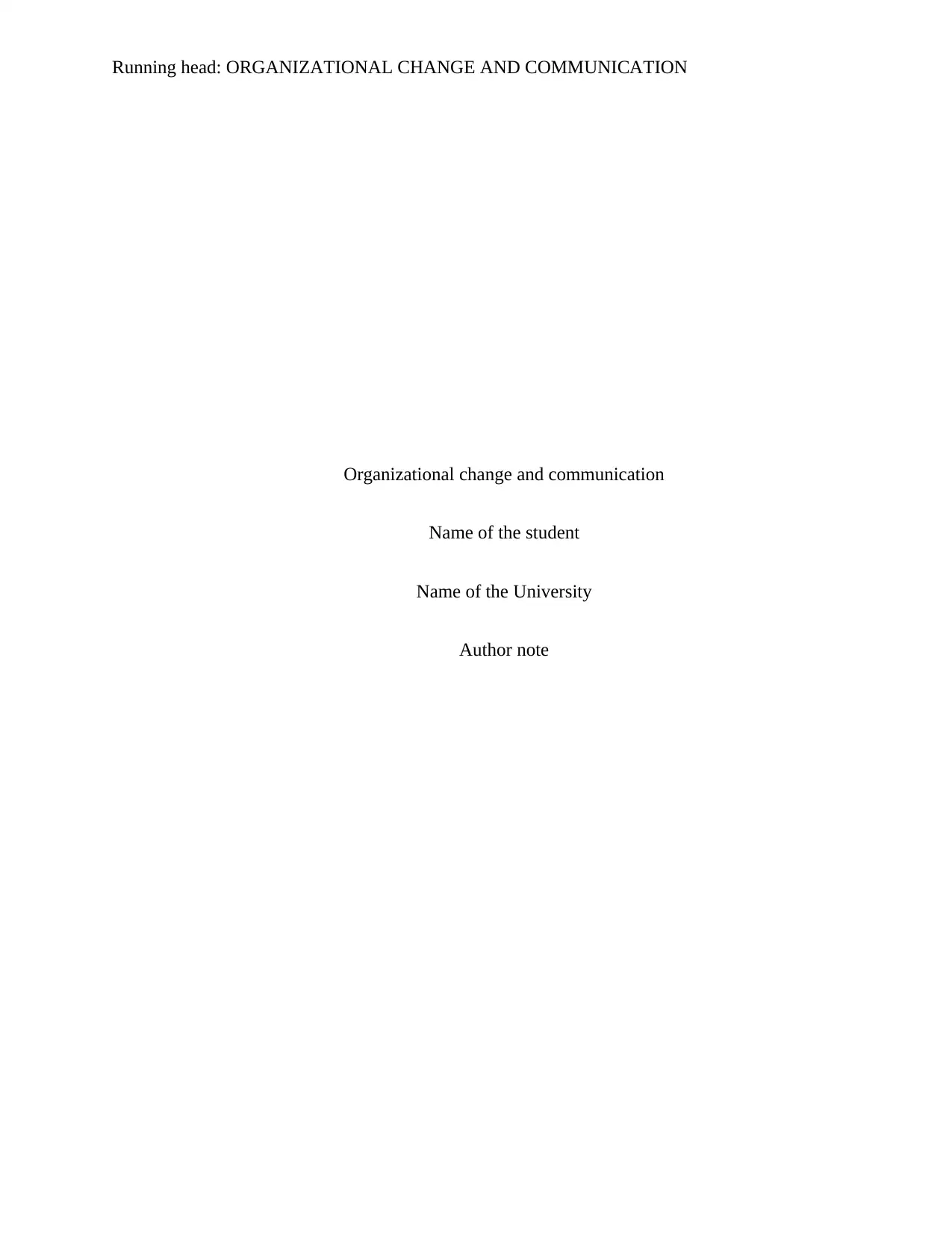
Running head: ORGANIZATIONAL CHANGE AND COMMUNICATION
Organizational change and communication
Name of the student
Name of the University
Author note
Organizational change and communication
Name of the student
Name of the University
Author note
Paraphrase This Document
Need a fresh take? Get an instant paraphrase of this document with our AI Paraphraser
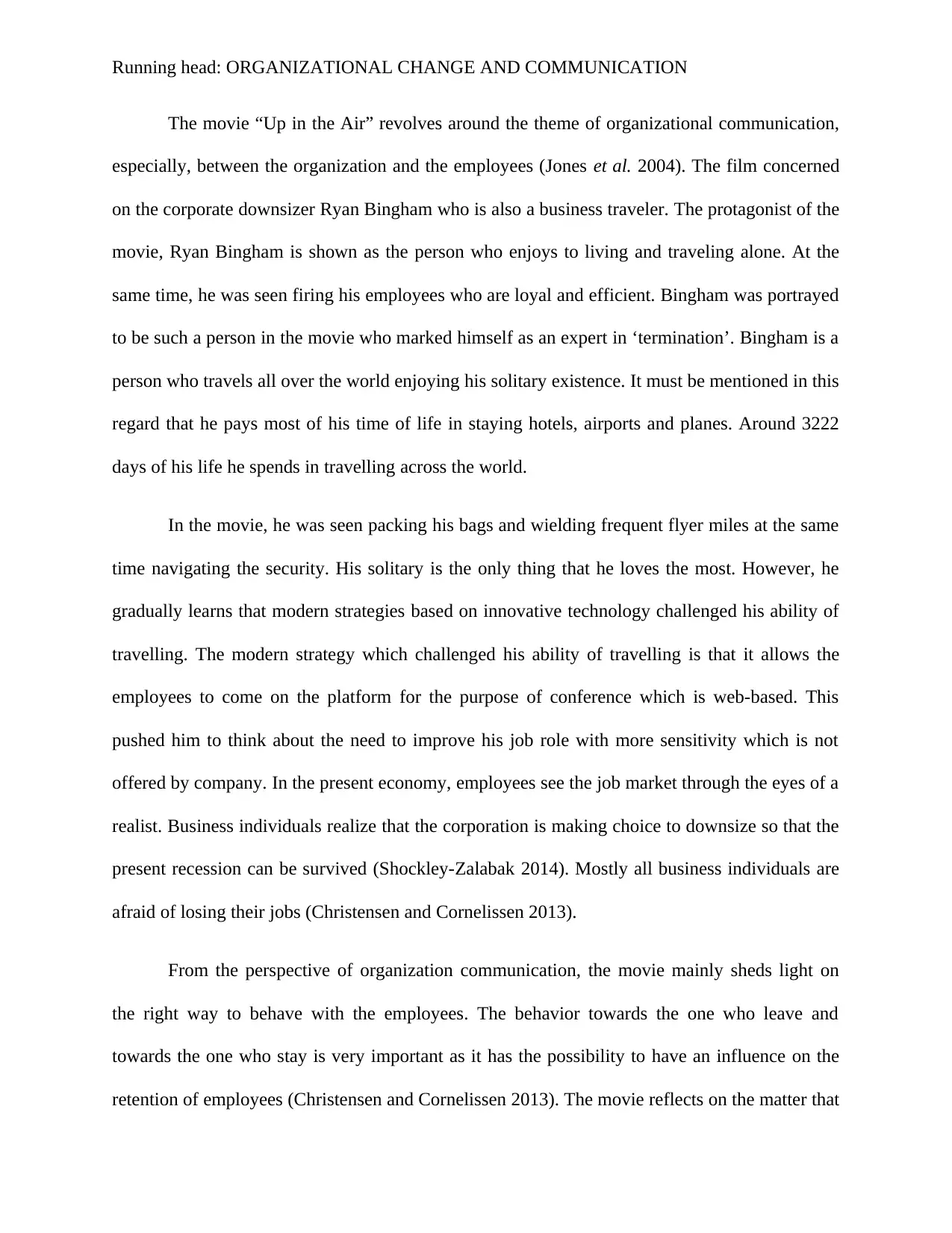
Running head: ORGANIZATIONAL CHANGE AND COMMUNICATION
The movie “Up in the Air” revolves around the theme of organizational communication,
especially, between the organization and the employees (Jones et al. 2004). The film concerned
on the corporate downsizer Ryan Bingham who is also a business traveler. The protagonist of the
movie, Ryan Bingham is shown as the person who enjoys to living and traveling alone. At the
same time, he was seen firing his employees who are loyal and efficient. Bingham was portrayed
to be such a person in the movie who marked himself as an expert in ‘termination’. Bingham is a
person who travels all over the world enjoying his solitary existence. It must be mentioned in this
regard that he pays most of his time of life in staying hotels, airports and planes. Around 3222
days of his life he spends in travelling across the world.
In the movie, he was seen packing his bags and wielding frequent flyer miles at the same
time navigating the security. His solitary is the only thing that he loves the most. However, he
gradually learns that modern strategies based on innovative technology challenged his ability of
travelling. The modern strategy which challenged his ability of travelling is that it allows the
employees to come on the platform for the purpose of conference which is web-based. This
pushed him to think about the need to improve his job role with more sensitivity which is not
offered by company. In the present economy, employees see the job market through the eyes of a
realist. Business individuals realize that the corporation is making choice to downsize so that the
present recession can be survived (Shockley-Zalabak 2014). Mostly all business individuals are
afraid of losing their jobs (Christensen and Cornelissen 2013).
From the perspective of organization communication, the movie mainly sheds light on
the right way to behave with the employees. The behavior towards the one who leave and
towards the one who stay is very important as it has the possibility to have an influence on the
retention of employees (Christensen and Cornelissen 2013). The movie reflects on the matter that
The movie “Up in the Air” revolves around the theme of organizational communication,
especially, between the organization and the employees (Jones et al. 2004). The film concerned
on the corporate downsizer Ryan Bingham who is also a business traveler. The protagonist of the
movie, Ryan Bingham is shown as the person who enjoys to living and traveling alone. At the
same time, he was seen firing his employees who are loyal and efficient. Bingham was portrayed
to be such a person in the movie who marked himself as an expert in ‘termination’. Bingham is a
person who travels all over the world enjoying his solitary existence. It must be mentioned in this
regard that he pays most of his time of life in staying hotels, airports and planes. Around 3222
days of his life he spends in travelling across the world.
In the movie, he was seen packing his bags and wielding frequent flyer miles at the same
time navigating the security. His solitary is the only thing that he loves the most. However, he
gradually learns that modern strategies based on innovative technology challenged his ability of
travelling. The modern strategy which challenged his ability of travelling is that it allows the
employees to come on the platform for the purpose of conference which is web-based. This
pushed him to think about the need to improve his job role with more sensitivity which is not
offered by company. In the present economy, employees see the job market through the eyes of a
realist. Business individuals realize that the corporation is making choice to downsize so that the
present recession can be survived (Shockley-Zalabak 2014). Mostly all business individuals are
afraid of losing their jobs (Christensen and Cornelissen 2013).
From the perspective of organization communication, the movie mainly sheds light on
the right way to behave with the employees. The behavior towards the one who leave and
towards the one who stay is very important as it has the possibility to have an influence on the
retention of employees (Christensen and Cornelissen 2013). The movie reflects on the matter that
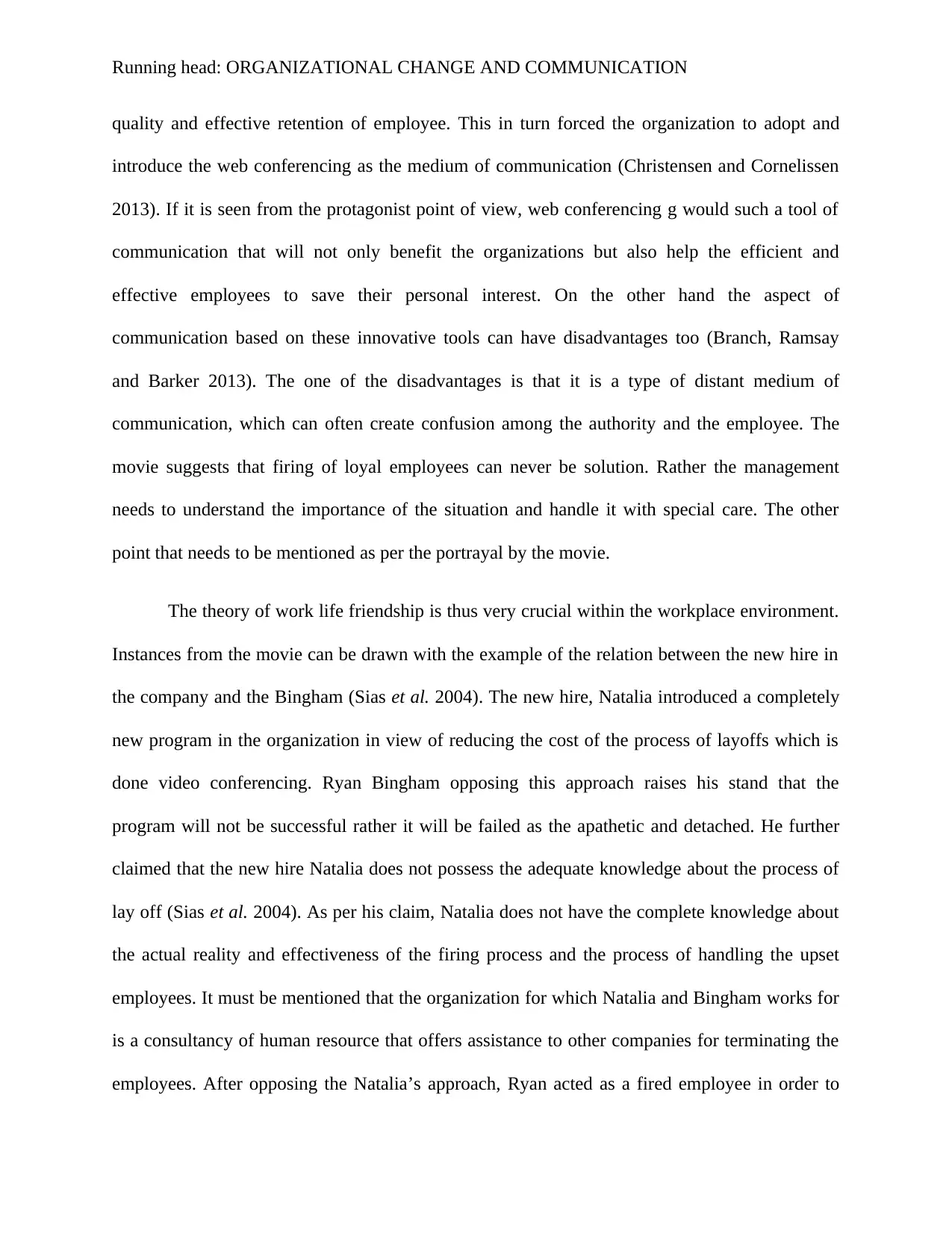
Running head: ORGANIZATIONAL CHANGE AND COMMUNICATION
quality and effective retention of employee. This in turn forced the organization to adopt and
introduce the web conferencing as the medium of communication (Christensen and Cornelissen
2013). If it is seen from the protagonist point of view, web conferencing g would such a tool of
communication that will not only benefit the organizations but also help the efficient and
effective employees to save their personal interest. On the other hand the aspect of
communication based on these innovative tools can have disadvantages too (Branch, Ramsay
and Barker 2013). The one of the disadvantages is that it is a type of distant medium of
communication, which can often create confusion among the authority and the employee. The
movie suggests that firing of loyal employees can never be solution. Rather the management
needs to understand the importance of the situation and handle it with special care. The other
point that needs to be mentioned as per the portrayal by the movie.
The theory of work life friendship is thus very crucial within the workplace environment.
Instances from the movie can be drawn with the example of the relation between the new hire in
the company and the Bingham (Sias et al. 2004). The new hire, Natalia introduced a completely
new program in the organization in view of reducing the cost of the process of layoffs which is
done video conferencing. Ryan Bingham opposing this approach raises his stand that the
program will not be successful rather it will be failed as the apathetic and detached. He further
claimed that the new hire Natalia does not possess the adequate knowledge about the process of
lay off (Sias et al. 2004). As per his claim, Natalia does not have the complete knowledge about
the actual reality and effectiveness of the firing process and the process of handling the upset
employees. It must be mentioned that the organization for which Natalia and Bingham works for
is a consultancy of human resource that offers assistance to other companies for terminating the
employees. After opposing the Natalia’s approach, Ryan acted as a fired employee in order to
quality and effective retention of employee. This in turn forced the organization to adopt and
introduce the web conferencing as the medium of communication (Christensen and Cornelissen
2013). If it is seen from the protagonist point of view, web conferencing g would such a tool of
communication that will not only benefit the organizations but also help the efficient and
effective employees to save their personal interest. On the other hand the aspect of
communication based on these innovative tools can have disadvantages too (Branch, Ramsay
and Barker 2013). The one of the disadvantages is that it is a type of distant medium of
communication, which can often create confusion among the authority and the employee. The
movie suggests that firing of loyal employees can never be solution. Rather the management
needs to understand the importance of the situation and handle it with special care. The other
point that needs to be mentioned as per the portrayal by the movie.
The theory of work life friendship is thus very crucial within the workplace environment.
Instances from the movie can be drawn with the example of the relation between the new hire in
the company and the Bingham (Sias et al. 2004). The new hire, Natalia introduced a completely
new program in the organization in view of reducing the cost of the process of layoffs which is
done video conferencing. Ryan Bingham opposing this approach raises his stand that the
program will not be successful rather it will be failed as the apathetic and detached. He further
claimed that the new hire Natalia does not possess the adequate knowledge about the process of
lay off (Sias et al. 2004). As per his claim, Natalia does not have the complete knowledge about
the actual reality and effectiveness of the firing process and the process of handling the upset
employees. It must be mentioned that the organization for which Natalia and Bingham works for
is a consultancy of human resource that offers assistance to other companies for terminating the
employees. After opposing the Natalia’s approach, Ryan acted as a fired employee in order to
⊘ This is a preview!⊘
Do you want full access?
Subscribe today to unlock all pages.

Trusted by 1+ million students worldwide
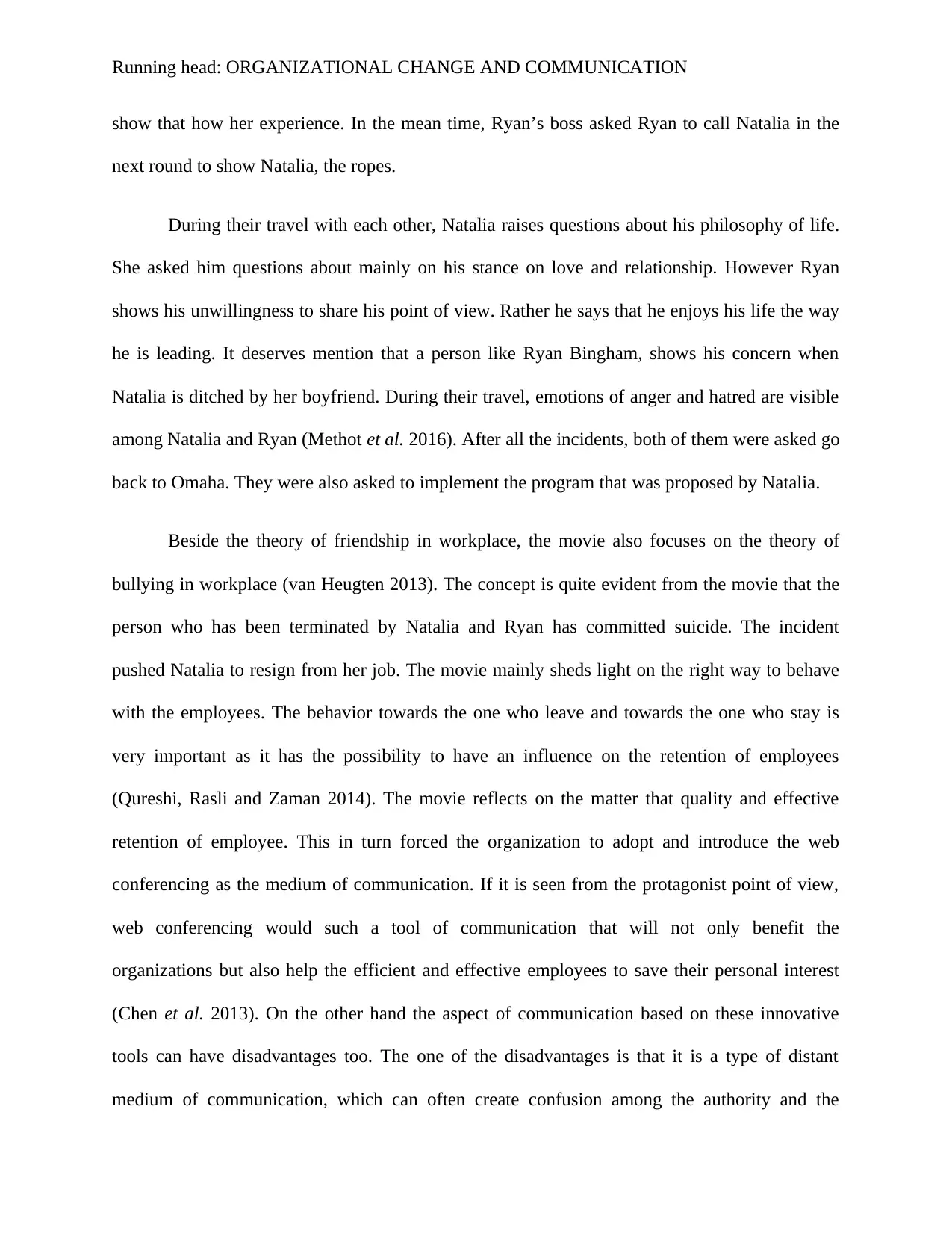
Running head: ORGANIZATIONAL CHANGE AND COMMUNICATION
show that how her experience. In the mean time, Ryan’s boss asked Ryan to call Natalia in the
next round to show Natalia, the ropes.
During their travel with each other, Natalia raises questions about his philosophy of life.
She asked him questions about mainly on his stance on love and relationship. However Ryan
shows his unwillingness to share his point of view. Rather he says that he enjoys his life the way
he is leading. It deserves mention that a person like Ryan Bingham, shows his concern when
Natalia is ditched by her boyfriend. During their travel, emotions of anger and hatred are visible
among Natalia and Ryan (Methot et al. 2016). After all the incidents, both of them were asked go
back to Omaha. They were also asked to implement the program that was proposed by Natalia.
Beside the theory of friendship in workplace, the movie also focuses on the theory of
bullying in workplace (van Heugten 2013). The concept is quite evident from the movie that the
person who has been terminated by Natalia and Ryan has committed suicide. The incident
pushed Natalia to resign from her job. The movie mainly sheds light on the right way to behave
with the employees. The behavior towards the one who leave and towards the one who stay is
very important as it has the possibility to have an influence on the retention of employees
(Qureshi, Rasli and Zaman 2014). The movie reflects on the matter that quality and effective
retention of employee. This in turn forced the organization to adopt and introduce the web
conferencing as the medium of communication. If it is seen from the protagonist point of view,
web conferencing would such a tool of communication that will not only benefit the
organizations but also help the efficient and effective employees to save their personal interest
(Chen et al. 2013). On the other hand the aspect of communication based on these innovative
tools can have disadvantages too. The one of the disadvantages is that it is a type of distant
medium of communication, which can often create confusion among the authority and the
show that how her experience. In the mean time, Ryan’s boss asked Ryan to call Natalia in the
next round to show Natalia, the ropes.
During their travel with each other, Natalia raises questions about his philosophy of life.
She asked him questions about mainly on his stance on love and relationship. However Ryan
shows his unwillingness to share his point of view. Rather he says that he enjoys his life the way
he is leading. It deserves mention that a person like Ryan Bingham, shows his concern when
Natalia is ditched by her boyfriend. During their travel, emotions of anger and hatred are visible
among Natalia and Ryan (Methot et al. 2016). After all the incidents, both of them were asked go
back to Omaha. They were also asked to implement the program that was proposed by Natalia.
Beside the theory of friendship in workplace, the movie also focuses on the theory of
bullying in workplace (van Heugten 2013). The concept is quite evident from the movie that the
person who has been terminated by Natalia and Ryan has committed suicide. The incident
pushed Natalia to resign from her job. The movie mainly sheds light on the right way to behave
with the employees. The behavior towards the one who leave and towards the one who stay is
very important as it has the possibility to have an influence on the retention of employees
(Qureshi, Rasli and Zaman 2014). The movie reflects on the matter that quality and effective
retention of employee. This in turn forced the organization to adopt and introduce the web
conferencing as the medium of communication. If it is seen from the protagonist point of view,
web conferencing would such a tool of communication that will not only benefit the
organizations but also help the efficient and effective employees to save their personal interest
(Chen et al. 2013). On the other hand the aspect of communication based on these innovative
tools can have disadvantages too. The one of the disadvantages is that it is a type of distant
medium of communication, which can often create confusion among the authority and the
Paraphrase This Document
Need a fresh take? Get an instant paraphrase of this document with our AI Paraphraser
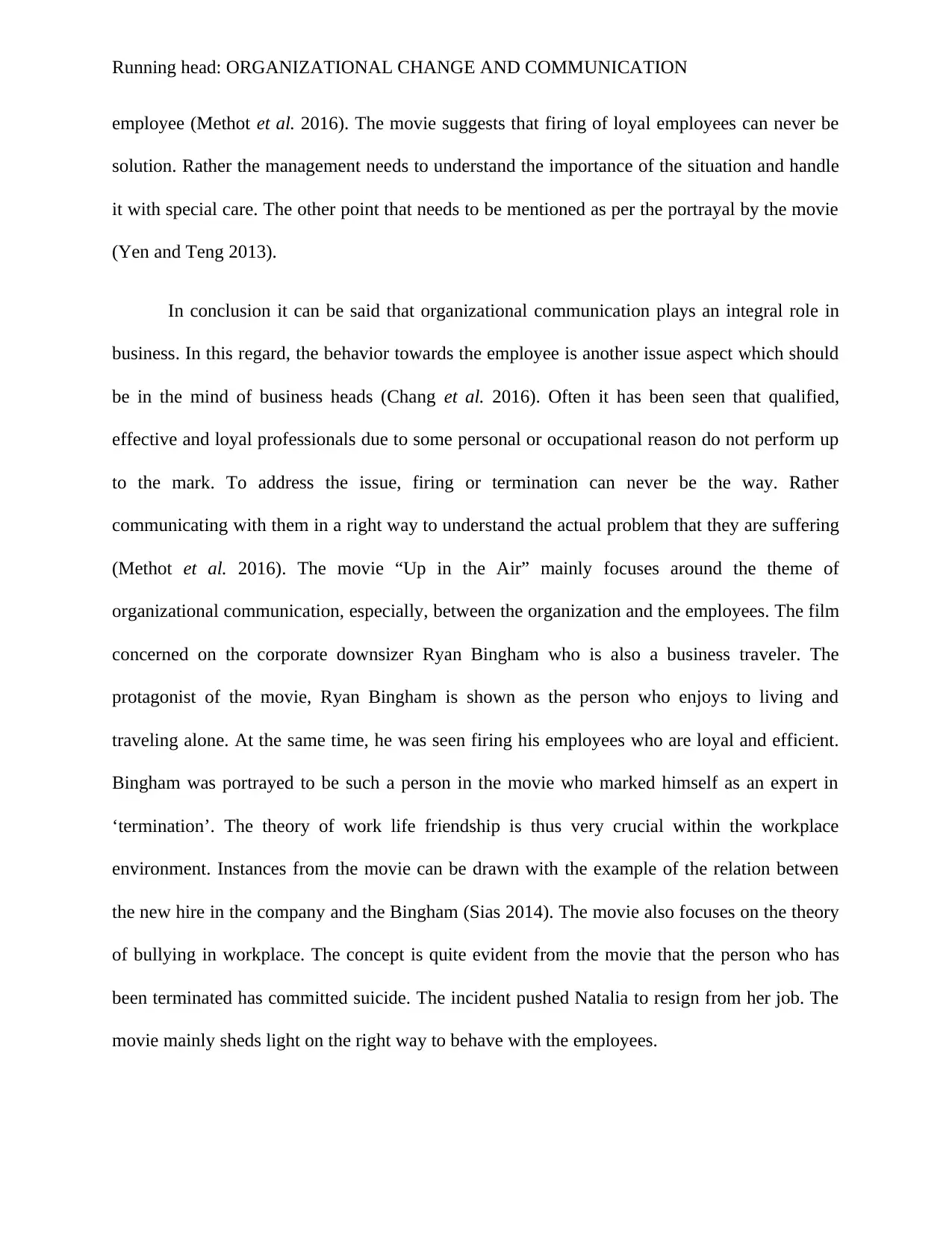
Running head: ORGANIZATIONAL CHANGE AND COMMUNICATION
employee (Methot et al. 2016). The movie suggests that firing of loyal employees can never be
solution. Rather the management needs to understand the importance of the situation and handle
it with special care. The other point that needs to be mentioned as per the portrayal by the movie
(Yen and Teng 2013).
In conclusion it can be said that organizational communication plays an integral role in
business. In this regard, the behavior towards the employee is another issue aspect which should
be in the mind of business heads (Chang et al. 2016). Often it has been seen that qualified,
effective and loyal professionals due to some personal or occupational reason do not perform up
to the mark. To address the issue, firing or termination can never be the way. Rather
communicating with them in a right way to understand the actual problem that they are suffering
(Methot et al. 2016). The movie “Up in the Air” mainly focuses around the theme of
organizational communication, especially, between the organization and the employees. The film
concerned on the corporate downsizer Ryan Bingham who is also a business traveler. The
protagonist of the movie, Ryan Bingham is shown as the person who enjoys to living and
traveling alone. At the same time, he was seen firing his employees who are loyal and efficient.
Bingham was portrayed to be such a person in the movie who marked himself as an expert in
‘termination’. The theory of work life friendship is thus very crucial within the workplace
environment. Instances from the movie can be drawn with the example of the relation between
the new hire in the company and the Bingham (Sias 2014). The movie also focuses on the theory
of bullying in workplace. The concept is quite evident from the movie that the person who has
been terminated has committed suicide. The incident pushed Natalia to resign from her job. The
movie mainly sheds light on the right way to behave with the employees.
employee (Methot et al. 2016). The movie suggests that firing of loyal employees can never be
solution. Rather the management needs to understand the importance of the situation and handle
it with special care. The other point that needs to be mentioned as per the portrayal by the movie
(Yen and Teng 2013).
In conclusion it can be said that organizational communication plays an integral role in
business. In this regard, the behavior towards the employee is another issue aspect which should
be in the mind of business heads (Chang et al. 2016). Often it has been seen that qualified,
effective and loyal professionals due to some personal or occupational reason do not perform up
to the mark. To address the issue, firing or termination can never be the way. Rather
communicating with them in a right way to understand the actual problem that they are suffering
(Methot et al. 2016). The movie “Up in the Air” mainly focuses around the theme of
organizational communication, especially, between the organization and the employees. The film
concerned on the corporate downsizer Ryan Bingham who is also a business traveler. The
protagonist of the movie, Ryan Bingham is shown as the person who enjoys to living and
traveling alone. At the same time, he was seen firing his employees who are loyal and efficient.
Bingham was portrayed to be such a person in the movie who marked himself as an expert in
‘termination’. The theory of work life friendship is thus very crucial within the workplace
environment. Instances from the movie can be drawn with the example of the relation between
the new hire in the company and the Bingham (Sias 2014). The movie also focuses on the theory
of bullying in workplace. The concept is quite evident from the movie that the person who has
been terminated has committed suicide. The incident pushed Natalia to resign from her job. The
movie mainly sheds light on the right way to behave with the employees.
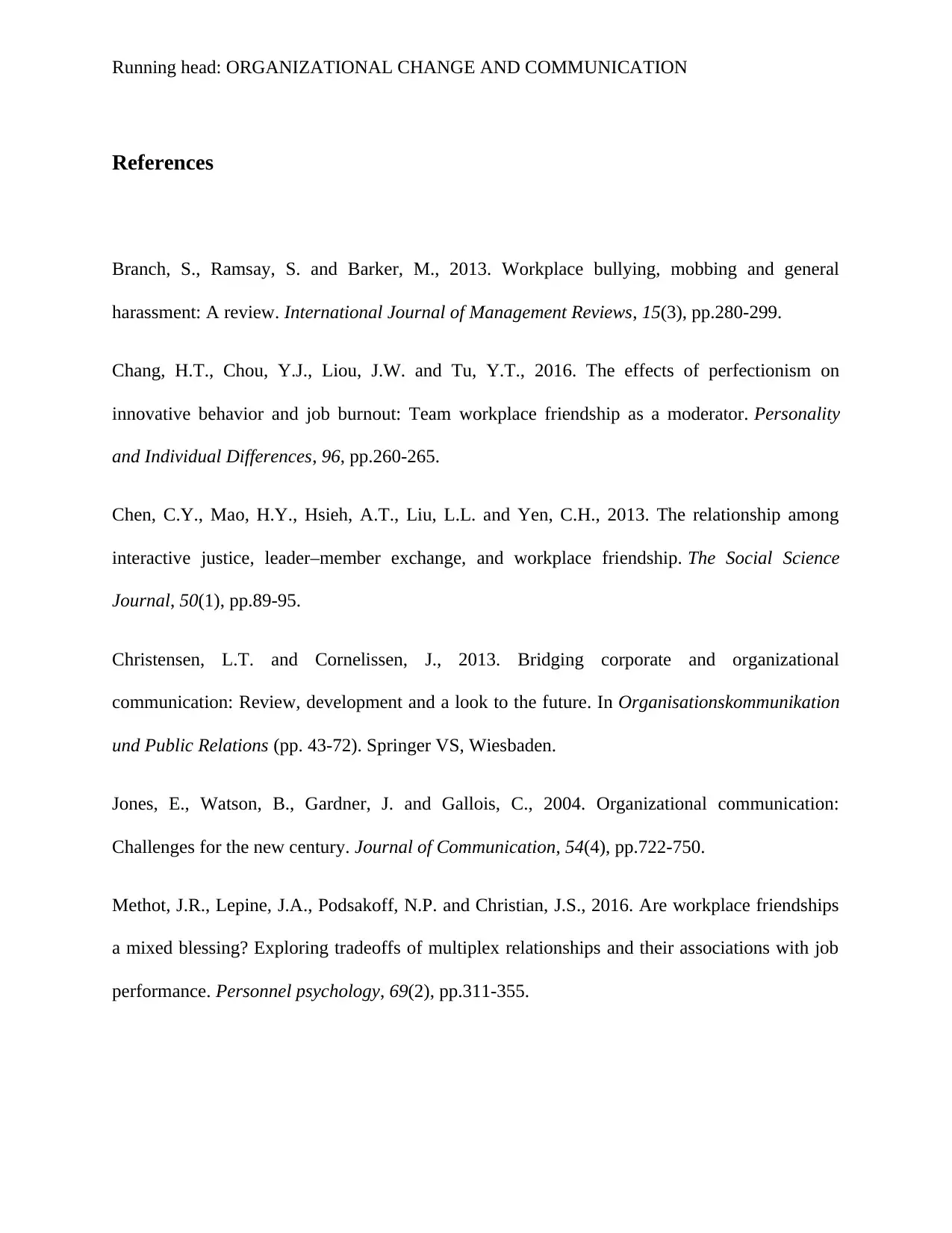
Running head: ORGANIZATIONAL CHANGE AND COMMUNICATION
References
Branch, S., Ramsay, S. and Barker, M., 2013. Workplace bullying, mobbing and general
harassment: A review. International Journal of Management Reviews, 15(3), pp.280-299.
Chang, H.T., Chou, Y.J., Liou, J.W. and Tu, Y.T., 2016. The effects of perfectionism on
innovative behavior and job burnout: Team workplace friendship as a moderator. Personality
and Individual Differences, 96, pp.260-265.
Chen, C.Y., Mao, H.Y., Hsieh, A.T., Liu, L.L. and Yen, C.H., 2013. The relationship among
interactive justice, leader–member exchange, and workplace friendship. The Social Science
Journal, 50(1), pp.89-95.
Christensen, L.T. and Cornelissen, J., 2013. Bridging corporate and organizational
communication: Review, development and a look to the future. In Organisationskommunikation
und Public Relations (pp. 43-72). Springer VS, Wiesbaden.
Jones, E., Watson, B., Gardner, J. and Gallois, C., 2004. Organizational communication:
Challenges for the new century. Journal of Communication, 54(4), pp.722-750.
Methot, J.R., Lepine, J.A., Podsakoff, N.P. and Christian, J.S., 2016. Are workplace friendships
a mixed blessing? Exploring tradeoffs of multiplex relationships and their associations with job
performance. Personnel psychology, 69(2), pp.311-355.
References
Branch, S., Ramsay, S. and Barker, M., 2013. Workplace bullying, mobbing and general
harassment: A review. International Journal of Management Reviews, 15(3), pp.280-299.
Chang, H.T., Chou, Y.J., Liou, J.W. and Tu, Y.T., 2016. The effects of perfectionism on
innovative behavior and job burnout: Team workplace friendship as a moderator. Personality
and Individual Differences, 96, pp.260-265.
Chen, C.Y., Mao, H.Y., Hsieh, A.T., Liu, L.L. and Yen, C.H., 2013. The relationship among
interactive justice, leader–member exchange, and workplace friendship. The Social Science
Journal, 50(1), pp.89-95.
Christensen, L.T. and Cornelissen, J., 2013. Bridging corporate and organizational
communication: Review, development and a look to the future. In Organisationskommunikation
und Public Relations (pp. 43-72). Springer VS, Wiesbaden.
Jones, E., Watson, B., Gardner, J. and Gallois, C., 2004. Organizational communication:
Challenges for the new century. Journal of Communication, 54(4), pp.722-750.
Methot, J.R., Lepine, J.A., Podsakoff, N.P. and Christian, J.S., 2016. Are workplace friendships
a mixed blessing? Exploring tradeoffs of multiplex relationships and their associations with job
performance. Personnel psychology, 69(2), pp.311-355.
⊘ This is a preview!⊘
Do you want full access?
Subscribe today to unlock all pages.

Trusted by 1+ million students worldwide
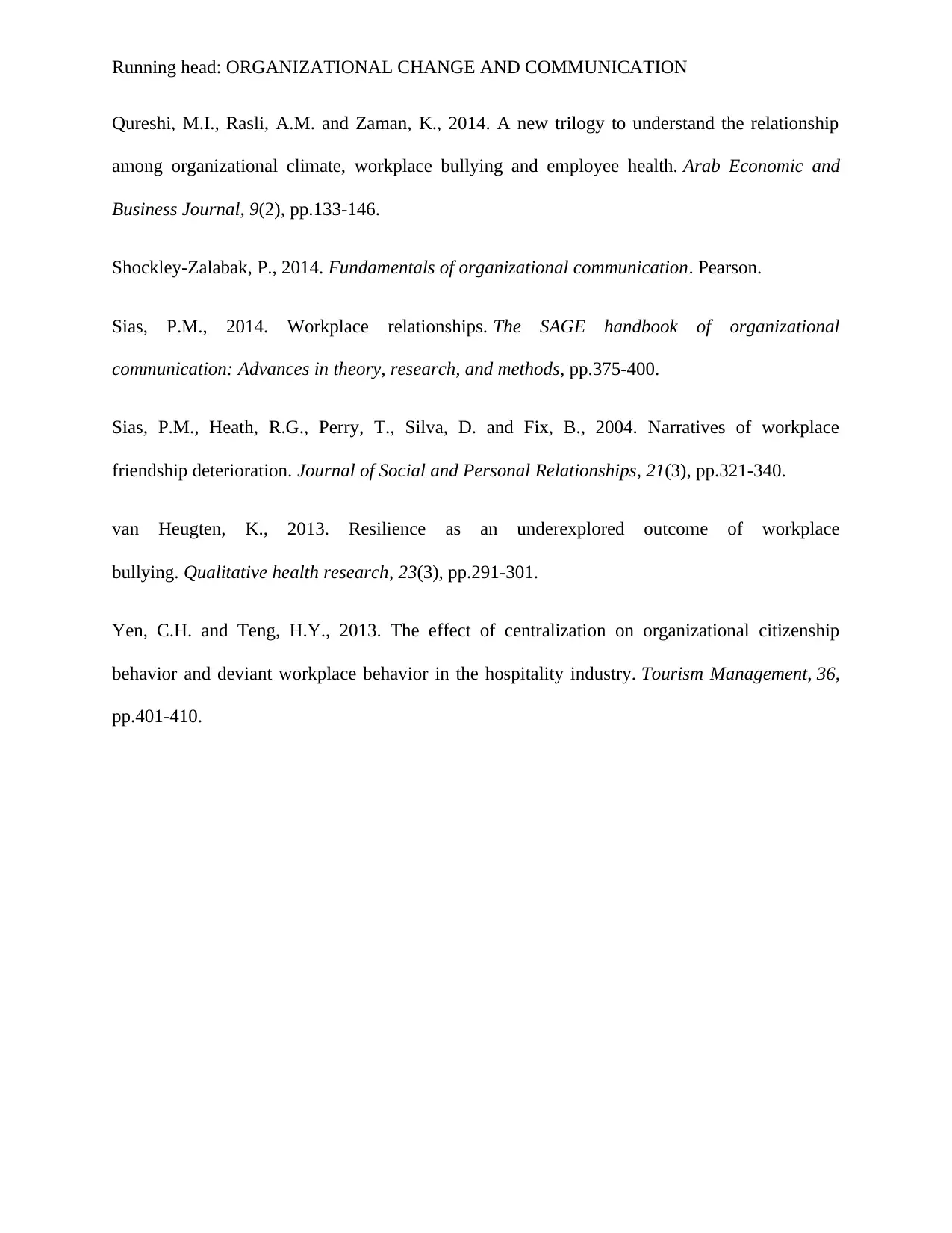
Running head: ORGANIZATIONAL CHANGE AND COMMUNICATION
Qureshi, M.I., Rasli, A.M. and Zaman, K., 2014. A new trilogy to understand the relationship
among organizational climate, workplace bullying and employee health. Arab Economic and
Business Journal, 9(2), pp.133-146.
Shockley-Zalabak, P., 2014. Fundamentals of organizational communication. Pearson.
Sias, P.M., 2014. Workplace relationships. The SAGE handbook of organizational
communication: Advances in theory, research, and methods, pp.375-400.
Sias, P.M., Heath, R.G., Perry, T., Silva, D. and Fix, B., 2004. Narratives of workplace
friendship deterioration. Journal of Social and Personal Relationships, 21(3), pp.321-340.
van Heugten, K., 2013. Resilience as an underexplored outcome of workplace
bullying. Qualitative health research, 23(3), pp.291-301.
Yen, C.H. and Teng, H.Y., 2013. The effect of centralization on organizational citizenship
behavior and deviant workplace behavior in the hospitality industry. Tourism Management, 36,
pp.401-410.
Qureshi, M.I., Rasli, A.M. and Zaman, K., 2014. A new trilogy to understand the relationship
among organizational climate, workplace bullying and employee health. Arab Economic and
Business Journal, 9(2), pp.133-146.
Shockley-Zalabak, P., 2014. Fundamentals of organizational communication. Pearson.
Sias, P.M., 2014. Workplace relationships. The SAGE handbook of organizational
communication: Advances in theory, research, and methods, pp.375-400.
Sias, P.M., Heath, R.G., Perry, T., Silva, D. and Fix, B., 2004. Narratives of workplace
friendship deterioration. Journal of Social and Personal Relationships, 21(3), pp.321-340.
van Heugten, K., 2013. Resilience as an underexplored outcome of workplace
bullying. Qualitative health research, 23(3), pp.291-301.
Yen, C.H. and Teng, H.Y., 2013. The effect of centralization on organizational citizenship
behavior and deviant workplace behavior in the hospitality industry. Tourism Management, 36,
pp.401-410.
1 out of 7
Your All-in-One AI-Powered Toolkit for Academic Success.
+13062052269
info@desklib.com
Available 24*7 on WhatsApp / Email
![[object Object]](/_next/static/media/star-bottom.7253800d.svg)
Unlock your academic potential
Copyright © 2020–2025 A2Z Services. All Rights Reserved. Developed and managed by ZUCOL.
